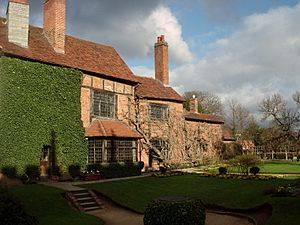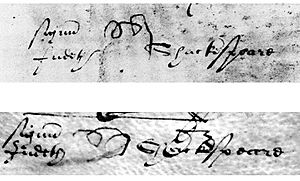Judith Quiney facts for kids
Quick facts for kids
Judith Quiney
|
|
|---|---|
| Born |
Judith Shakespeare
c. 1585 |
| Died | 9 February 1662 (aged 77) |
| Nationality | English |
| Spouse(s) | |
| Children |
|
| Parent(s) | William Shakespeare (father) Anne Hathaway (mother) |
| Signature | |
 |
|
Judith Quiney (baptised 2 February 1585 – 9 February 1662), née Shakespeare, was the younger daughter of William Shakespeare and Anne Hathaway and the fraternal twin of their only son Hamnet Shakespeare. She married Thomas Quiney, a vintner of Stratford-upon-Avon. The circumstances of the marriage, including Quiney's misconduct, may have prompted the rewriting of Shakespeare's will. Thomas was struck out, while Judith's inheritance was attached with provisions to safeguard it from her husband. The bulk of Shakespeare's estate was left, in an elaborate fee tail, to his elder daughter Susanna and her male heirs.
Judith and Thomas Quiney had three children. By the time of Judith Quiney's death, she had outlived her children by many years. She has been depicted in several works of fiction as part of an attempt to piece together unknown portions of her father's life.
Contents
Birth and early life
Judith Shakespeare was the daughter of William Shakespeare and Anne Hathaway. She was the younger sister of Susanna and the twin sister of Hamnet. Hamnet, however, died at the age of eleven. Their baptisms on 2 February 1585 were recorded as "Hamnet & Judeth sonne & daughter to William Shakspere" by the vicar, Richard Barton of Coventry, in the parish register for Holy Trinity Church, Stratford-upon-Avon. The twins were named after a husband and wife, Hamnet and Judith Sadler, who were friends of the parents. Hamnet Sadler was a baker in Stratford.
Unlike her father and her husband, Judith Shakespeare was probably illiterate. In 1611, she witnessed the deed of sale of a house for £131 (equivalent to £20,870 in 2021) to William Mountford, a wheelwright of Stratford, from Elizabeth Quiney, her future mother-in-law, and Elizabeth's eldest son, Adrian. Judith signed twice with a mark instead of her name.
Marriage
On 10 February 1616, Judith Shakespeare married Thomas Quiney, a vintner of Stratford, in Holy Trinity Church. The assistant vicar, Richard Watts, who later married Quiney's sister Mary, probably officiated. The wedding took place during the pre-Lenten season of Shrovetide, which was a prohibitive time for marriages. In 1616, the period in which marriages were banned without dispensation from the church, including Ash Wednesday and Lent, started on 23 January, Septuagesima Sunday and ended on 7 April, the Sunday after Easter. Hence the marriage required a special licence issued by the Bishop of Worcester, which the couple had failed to obtain. Presumably they had posted the required banns in church, since Walter Wright of Stratford was cited for marrying without banns or licence, but this was not considered sufficient. The infraction was a minor one apparently caused by the minister, as three other couples were also wed that February. Quiney was nevertheless summoned by Walter Nixon to appear before the consistory court in Worcester. (This same Walter Nixon was later involved in a Star Chamber case and was found guilty of forging signatures and taking bribes.) Quiney failed to appear by the required date. The register recorded the judgement, which was excommunication, on or about 12 March 1616. It is unknown if Judith was also excommunicated, but in any case the punishment did not last long. In November of the same year, they were back in church for the baptism of their firstborn child.
Chapel Lane, Atwood's, and The Cage
Where the Quineys lived after their marriage is unknown. Judith owned her father's cottage on Chapel Lane, Stratford; while Thomas had held, since 1611, the lease on a tavern called "Atwood's" on High Street. The cottage later passed from Judith to her sister as part of the settlement in their father's will. In July 1616 Thomas swapped houses with his brother-in-law, William Chandler, moving his vintner's shop to the upper half of a house at the corner of High Street and Bridge Street. This house was known as "The Cage" and is the house traditionally associated with Judith Quiney. In the 20th century The Cage was for a time a Wimpy Bar before being turned into the Stratford Information Office.
The Cage provides further insight into why Shakespeare would not have trusted Judith's husband. Around 1630 Quiney tried to sell the lease on the house but was prevented by his kinsmen. In 1633, to protect the interests of Judith and the children, the lease was signed over to the trust of John Hall, Susanna's husband, Thomas Nash, the husband of Judith's niece, and Richard Watts, vicar of nearby Harbury, who was Quiney's brother-in-law and who had officiated at Thomas and Judith's wedding. Eventually, in November 1652, the lease to The Cage ended up in the hands of Thomas' eldest brother, Richard Quiney, a grocer in London.
William Shakespeare's last will and testament

The inauspicious beginnings of Judith's marriage, in spite of her husband and his family being otherwise unexceptional, has led to speculation that this was the cause for William Shakespeare's hastily altered last will and testament. He first summoned his lawyer, Francis Collins, in January 1616. On 25 March, he made further alterations, probably because he was dying and because of his concerns about Quiney. In the first bequest of the will, there had been a provision "vnto my sonne in L[aw]"; but "sonne in L[aw]" was then struck out, with Judith's name inserted in its stead. To this daughter he bequeathed £100 (equivalent to £13,124 in 2021) "in discharge of her marriage porcion"; another £50 (£6,562 in 2021) if she were to relinquish the Chapel Lane cottage; and, if she or any of her children were still alive at the end of three years following the date of the will, a further £150 (£19,686 in 2021), of which she was to receive the interest but not the principal. This money was explicitly denied to Thomas Quiney unless he were to bestow on Judith lands of equal value. In a separate bequest, Judith was given "my broad silver gilt bole."
Finally, for the bulk of his estate, which included his main house, New Place, his two houses on Henley Street and various lands in and around Stratford, Shakespeare had set up an entail. His estate was bequeathed, in descending order of choice, to the following: 1) his daughter, Susanna Hall; 2) upon Susanna's death, "to the first sonne of her bodie lawfullie yssueing & to the heires Males of the bodie of the saied first Sonne lawfullie yssueing"; 3) to Susanna's second son and his male heirs; 4) to Susanna's third son and his male heirs; 5) to Susanna's "ffourth ... ffyfth sixte & Seaventh sonnes" and their male heirs; 6) to Elizabeth Hall, Susanna and John Hall's firstborn, and her male heirs; 7) to Judith and her male heirs; or 8) to whatever heirs the law would normally recognise. This elaborate entail is usually taken to indicate that Thomas Quiney was not to be entrusted with Shakespeare's inheritance, although some have speculated that it might simply indicate that Susanna was the favoured child.
Children
Judith and Thomas Quiney had three children:
- Shakespeare (baptised 23 November 1616 – buried 8 May 1617)
- Richard (baptised 9 February 1618 – buried 6 February 1639)
- Thomas (baptised 23 January 1620 – buried 28 January 1639)
Shakespeare was named for his grandfather. Richard's name was common among the Quineys: his paternal grandfather and an uncle were named Richard.
Shakespeare Quiney died at six months of age. Richard and Thomas Quiney were buried within one month of each other, 21 and 19 years old, respectively. The cause of death of her two elder sons is not known for certain. The deaths of all of Judith's children resulted in new legal consequences. The entail on her father's inheritance led Susanna, along with her daughter and son-in-law, to make a settlement using a rather elaborate legal device for the inheritance of her own branch of the family. Legal wrangling continued for another thirteen years, until 1652.
Death
Judith Quiney was buried on 9 February 1662, a week after her 77th birthday. She outlived her last surviving child by 23 years. She was buried in the grounds of Holy Trinity Church, but the exact location of her grave is unknown. Of her husband, the records show some of his later years. It has been speculated that he may have died in 1662 or 1663, when the parish burial records are incomplete, or that he may have left Stratford-upon-Avon. He is known to have had a nephew, living in London, who by this time was holding the lease to The Cage.



